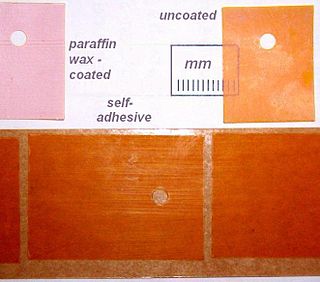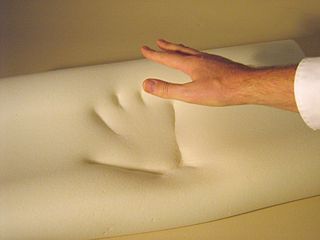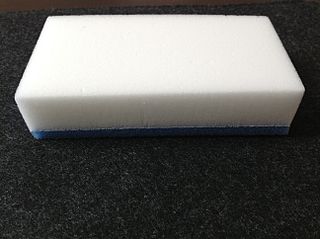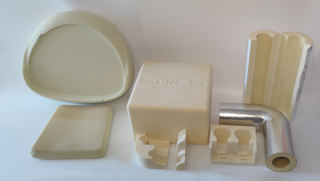
Foams are materials formed by trapping pockets of gas in a liquid or solid.

In materials science, a thermosetting polymer, often called a thermoset, is a polymer that is obtained by irreversibly hardening ("curing") a soft solid or viscous liquid prepolymer (resin). Curing is induced by heat or suitable radiation and may be promoted by high pressure or mixing with a catalyst. Heat is not necessarily applied externally, and is often generated by the reaction of the resin with a curing agent. Curing results in chemical reactions that create extensive cross-linking between polymer chains to produce an infusible and insoluble polymer network.

Kapton is a polyimide film used in flexible printed circuits and space blankets, which are used on spacecraft, satellites, and various space instruments. Invented by the DuPont Corporation in the 1960s, Kapton remains stable across a wide range of temperatures, from 4 to 673 K. Kapton is used in electronics manufacturing, space applications, with x-ray equipment, and in 3D printing applications. Its favorable thermal properties and outgassing characteristics result in its regular use in cryogenic applications and in situations where high vacuum environments are experienced.

Polyimide is a polymer containing imide groups belonging to the class of high-performance plastics. With their high heat-resistance, polyimides enjoy diverse applications in roles demanding rugged organic materials, such as high temperature fuel cells, displays, and various military roles. A classic polyimide is Kapton, which is produced by condensation of pyromellitic dianhydride and 4,4'-oxydianiline.

Glass wool is an insulating material made from glass fiber arranged using a binder into a texture similar to wool. The process traps many small pockets of air between the glass, and these small air pockets result in high thermal insulation properties. Glass wool is produced in rolls or in slabs, with different thermal and mechanical properties. It may also be produced as a material that can be sprayed or applied in place, on the surface to be insulated. The modern method for producing glass wool was invented by Games Slayter while he was working at the Owens-Illinois Glass Co.. He first applied for a patent for a new process to make glass wool in 1933.

Memory foam consists mainly of polyurethane with additional chemicals that increase its viscosity and density. It is often referred to as "viscoelastic" polyurethane foam, or low-resilience polyurethane foam (LRPu). The foam bubbles or ‘cells’ are open, effectively creating a matrix through which air can move. Higher-density memory foam softens in reaction to body heat, allowing it to mold to a warm body in a few minutes. Newer foams may recover their original shape more quickly.
Polyamide-imides are either thermosetting or thermoplastic, amorphous polymers that have exceptional mechanical, thermal and chemical resistant properties. Polyamide-imides are used extensively as wire coatings in making magnet wire. They are prepared from isocyanates and TMA in N-methyl-2-pyrrolidone (NMP). A prominent distributor of polyamide-imides is Solvay Specialty Polymers, which uses the trademark Torlon.

Syntactic foams are composite materials synthesized by filling a metal, polymer, cementitious or ceramic matrix with hollow spheres called microballoons or cenospheres or non-hollow spheres as aggregates. In this context, "syntactic" means "put together." The presence of hollow particles results in lower density, higher specific strength, lower coefficient of thermal expansion, and, in some cases, radar or sonar transparency.

Ethylene-vinyl acetate (EVA), also known as poly(ethylene-vinyl acetate) (PEVA), is a copolymer of ethylene and vinyl acetate. The weight percent of vinyl acetate usually varies from 10 to 50%, with the remainder being ethylene. There are three different types of EVA copolymer, which differ in the vinyl acetate (VA) content and the way the materials are used.

In materials science, a metal foam is a material or structure consisting of a solid metal with gas-filled pores comprising a large portion of the volume. The pores can be sealed or interconnected. The defining characteristic of metal foams is a high porosity: typically only 5–25% of the volume is the base metal. The strength of the material is due to the square–cube law.

Foam rubber refers to rubber that has been manufactured with a foaming agent to create an air-filled matrix structure. Commercial foam rubbers are generally made of synthetic rubber, natural latex or polyurethane. Latex foam rubber, used in mattresses, is well known for its endurance. Polyurethane is a thermosetting polymer that comes from combination of Methyl di-isocyanate and polyethylene and some other chemical additives.
Sorbothane is the brand name of a synthetic viscoelastic urethane polymer used as a shock absorber and vibration damper. It is manufactured by Sorbothane, Inc., based in Kent, Ohio.

Vespel is the trademark of a range of durable high-performance polyimide-based plastics made by DuPont.

Melamine foam is a foam-like material consisting of a melamine-formaldehyde condensate. It is the active component of a number of abrasive cleaner sponges, notably the Magic Eraser.

Foam latex or latex foam rubber is a lightweight form of latex containing bubbles known as cells, created from liquid latex. The foam is generally created though the Dunlop or Talalay process in which a liquid latex is foamed and then cured in a mold to extract the foam.
Ceramic foam is a tough foam made from ceramics. Manufacturing techniques include impregnating open-cell polymer foams internally with ceramic slurry and then firing in a kiln, leaving only ceramic material. The foams may consist of several ceramic materials such as aluminium oxide, a common high-temperature ceramic, and gets insulating properties from the many tiny air-filled voids within the material.
A blowing agent is a substance which is capable of producing a cellular structure via a foaming process in a variety of materials that undergo hardening or phase transition, such as polymers, plastics, and metals. They are typically applied when the blown material is in a liquid stage. The cellular structure in a matrix reduces density, increasing thermal and acoustic insulation, while increasing relative stiffness of the original polymer.
A thermoset polymer matrix is a synthetic polymer reinforcement where polymers act as binder or matrix to secure in place incorporated particulates, fibres or other reinforcements. They were first developed for structural applications, such as glass-reinforced plastic radar domes on aircraft and graphite-epoxy payload bay doors on the Space Shuttle.
Upilex is a heat-resistant polyimide film that is the product of the polycondensation reaction between biphenyl tetracarboxylic dianhydride (BPDA) monomers and a diamine. Its properties include dimensional stability, low water absorption, high chemical resistance and high mechanical properties, high heat and chemical resistance. It was developed by UBE Industries. Upilex-S is the standard grade but other grades include Upilex-RN, VT, CA and SGA. Upilex-S is used when excellent mechanical properties are required. Upilex-RN possesses excellent molding processability, while Upilex-VT has superior heat bonding characteristics. General applications of Upilex include their use in flexible printed circuits, electric motor and generator insulation, high temperature wire and cable wrapping, and specialty pressure sensitive tapes. Polyimides have also been extensively studied in gas and humidity sensors, where the concentration is determined by monitoring the capacitance of modified Upilex films. With advantages of flexibility and easy functionalization, Upilex films are often used as substrate materials in biosensor platforms. For instance, it is possible to electropolymerize onto these films or attach enzymes to it for the detection of glucose.

Polyurethane foam is a specialist material used for thermal insulation and other applications. It is a solid polymeric foam based on polyurethane chemistry.














